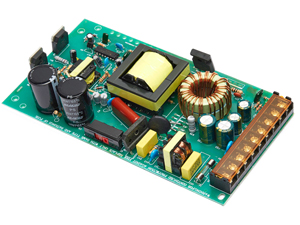
Wenzhou wode electrical co.,LTD
Tel: +86 577 62602806Phone: 86-18106781616E-mail: wode@wodeps.com

Tel: +86 577 62602806Phone: 86-18106781616E-mail: wode@wodeps.com

Date:2021.10.13 Views:3578
Switching power supplies differ from linear power supplies in how the primary AC voltage is converted to an output DC voltage. Switching mode power supplies use power transistors to generate a high frequency voltage which is passed through a small transformer and then filtered to remove the AC component and noise. Linear power supplies provide DC power by passing the primary AC voltage through a transformer and then filtering it to remove the AC component. Switching power supply offers higher efficiency, lighter weight, longer retention times and the ability to handle a wider range of input voltages. Linear power supplies are typically cheaper but have limited functionality and tend to be physically larger. Although switch mode power supplies can generate high frequency noise due to the use of power transistors.
The ambient temperature rating is the relationship between the labeled power rating, the ambient operating temperature of the application and the actual power capacity after derating if necessary. Many manufacturers list their power supply ratings based on a 40?C environment. This means that the nameplate rating (ie: 60 watts) is only applicable if the unit is operated in an environment where the ambient temperature is equal to or below 40?C.
Switching Power Supply
If the unit is operated above 40?C, the power capacity of the unit must be significantly reduced, with full derating typically occurring at 50?C. In this example, a 60 Watt 40?C design would be re-evaluated to 30 Watt in a 45? environment, and would not operate in a 50? environment. However, Micron power supplies are designed and nameplate rated to operate up to 60?C. Micron designs can still operate above the 60?C design parameter, but must be gradually derated as the ambient temperature approaches 70?C.
This is important in two ways. Firstly, the specifying engineer must match the ambient operating temperature to the appropriate power supply design in order to avoid overloading the power supply. Secondly, purchasers of power supplies must be aware of the difference in operating temperature ratings in order to make an informed purchasing decision, as the difference in performance between 40? and 60? designs is significant and therefore the unit cost is lower for smaller designs.

Switching Power Supply
It is also important to understand the difference between 'operating range' and 'operating power range'. Many manufacturers list the 'operating range' of their power supplies as -20 to 70?C, even though 40?C designs do not provide power above 49?C. If there is any doubt as to the suitability of a particular power supply design for the expected ambient operating temperature, the user should request a temperature/power graph showing the point and range of power derating required by the equipment.
Firstly, the CE mark requires power factor correction as an indication of compliance with EN61000-3-2. Secondly, the label 'power factor corrected' is somewhat misleading as the aim of the standard is to inject harmful harmonic 'noise' into the control and power supply circuitry connected to the power supply. To achieve this, power supply manufacturers incorporate a filtering circuit into the unit design. Some manufacturers use passive filtering designs that minimise harmonics. Micron uses an active filtering design which provides excellent filtering.
Wode got the quality system certificated of CE LVD EMC ROHS for switching power supply and waterproof degree IP68 for LED driver, we have established steady commercial relation with European, North America, South America, Middle east customers, and many famous companies have chosen us as OEM supplier.
If you want to get more information about the best switching power supply, welcome to contact us today or request a quote.